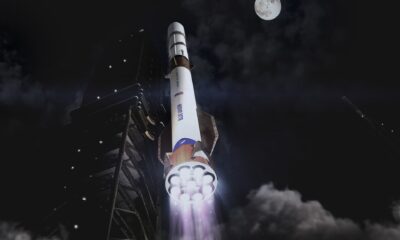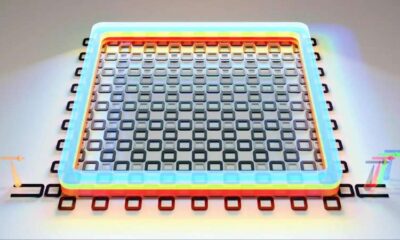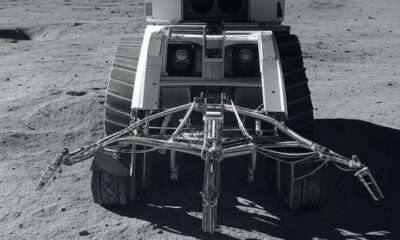Science
Interlune Aims for Lunar Helium-3 Mining by 2028

A pioneering mining company, Interlune, has announced its plans to extract helium-3 from the lunar surface by March 2028. This rare isotope, which has the potential to revolutionize clean energy and advanced technologies, has been identified in significant deposits due to billions of years of exposure to solar wind. The announcement highlights a growing interest in space mining as nations and private entities seek to exploit the moon’s untapped resources.
The implications of helium-3 mining extend beyond energy. Industry experts value helium-3 at nearly $20 million per kilogram, driven by its applications in quantum computing and nuclear fusion. Unlike its more common counterpart, helium-4, helium-3 is non-radioactive and presents a promising avenue for sustainable and waste-free energy production. As global demand for clean energy solutions escalates, helium-3 could play a critical role in addressing these needs.
Geopolitical Landscape of Lunar Resource Competition
This announcement arrives during a time of heightened competition between superpowers, particularly the United States and China, both of which are eager to secure lunar dominance. According to a report from Space.com, Interlune’s efforts are part of a broader strategy to harness helium-3 for applications in quantum computing, where it is essential for maintaining ultra-low temperatures.
Interlune has already secured agreements to supply up to 10,000 liters of extracted helium-3, signaling early confidence in the market. The company has introduced a prototype harvester capable of processing 110 tons of lunar soil per hour, addressing significant logistical challenges associated with lunar operations. This machinery aims to minimize environmental disruption while navigating the harsh lunar landscape.
Technological Innovations and Economic Implications
Beyond energy production, helium-3 has potential applications in medical imaging and supercomputing, where scarcity on Earth has driven up prices. As reported in Forbes, Interlune is developing robotic systems for autonomous mining, with operations anticipated to be active by 2028. This timeline aligns with NASA’s Artemis program and China’s Chang’e missions, which could establish the necessary infrastructure for transport and processing of lunar materials.
Challenges remain, including the high costs associated with space travel and the uncertain economics of transporting resources back to Earth. Nevertheless, supporters argue that utilizing lunar materials for in-situ resource utilization could mitigate expenses and support future lunar habitats.
The interest in helium-3 is not limited to the United States and China; Russia has also entered the conversation, viewing helium-3 as a key asset in reshaping global energy dynamics. The race for lunar resources is being called “moon gold” by some industry analysts, reflecting the intense geopolitical stakes involved.
Interlune’s venture has attracted considerable financial backing, with funds raised for deploying multispectral cameras to enhance resource mapping, as detailed in Autoevolution. A significant partnership with quantum cryogenics firm Bluefors marks one of the largest space resource contracts to date, emphasizing helium-3’s importance in advancing technological capabilities.
Ethically, the push for space mining raises questions about equitable access to lunar resources under the Outer Space Treaty. Critics express concerns over potential new forms of colonialism, while advocates highlight the potential for shared technological benefits, including safer nuclear fusion energy that could contribute to combating climate change.
Looking forward, successful helium-3 mining could catalyze a broader space economy, encompassing resources such as water ice and rare earth minerals. Insights from 21st Century Tech Blog suggest that this could support permanent lunar settlements, reducing dependency on Earth-sourced materials. For industry insiders, the scalability of Interlune’s prototypes will be a crucial metric, potentially attracting billions in investment and transforming the moon from a scientific frontier to a commercial hub.
As extraction technologies continue to evolve, the dream of harnessing cosmic resources becomes more tangible, promising significant impacts on Earth’s technological landscape in the years to come.
-

 Technology4 months ago
Technology4 months agoDiscover the Top 10 Calorie Counting Apps of 2025
-

 Health2 months ago
Health2 months agoBella Hadid Shares Health Update After Treatment for Lyme Disease
-

 Health3 months ago
Health3 months agoErin Bates Shares Recovery Update Following Sepsis Complications
-

 Technology3 weeks ago
Technology3 weeks agoDiscover 2025’s Top GPUs for Exceptional 4K Gaming Performance
-

 Technology2 months ago
Technology2 months agoElectric Moto Influencer Surronster Arrested in Tijuana
-

 Technology4 months ago
Technology4 months agoDiscover How to Reverse Image Search Using ChatGPT Effortlessly
-

 Technology4 months ago
Technology4 months agoMeta Initiates $60B AI Data Center Expansion, Starting in Ohio
-

 Technology4 months ago
Technology4 months agoRecovering a Suspended TikTok Account: A Step-by-Step Guide
-

 Health4 months ago
Health4 months agoTested: Rab Firewall Mountain Jacket Survives Harsh Conditions
-

 Lifestyle4 months ago
Lifestyle4 months agoBelton Family Reunites After Daughter Survives Hill Country Floods
-

 Technology3 months ago
Technology3 months agoUncovering the Top Five Most Challenging Motorcycles to Ride
-

 Technology4 weeks ago
Technology4 weeks agoDiscover the Best Wireless Earbuds for Every Lifestyle





















